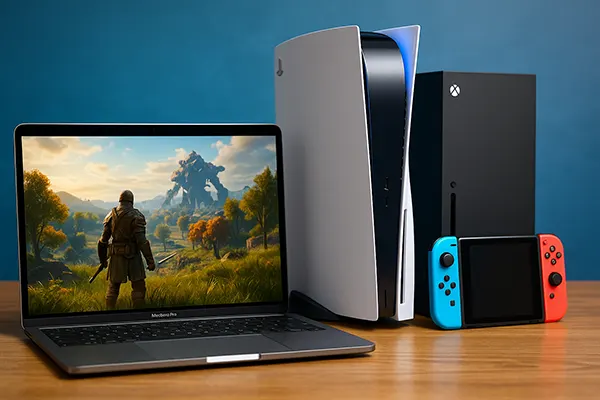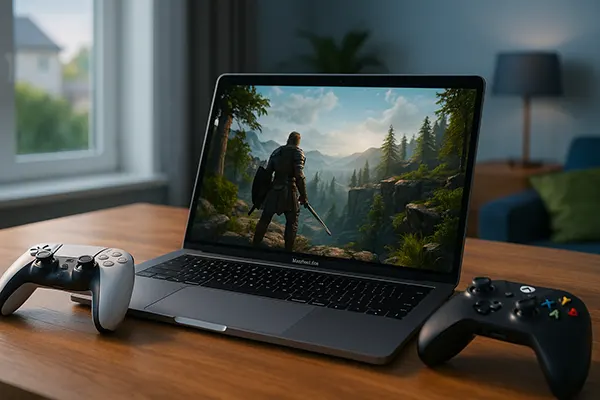Emulating Modern Consoles (2020s) on Mac: What Works and What Doesn’t in 2025

With the evolution of Apple Silicon, interest in running console emulators on MacBooks has surged. Gamers are eager to test whether modern titles from PlayStation 5, Xbox Series X | S, and Nintendo Switch can be replicated with stable performance on macOS. By 2025, software compatibility and hardware advancements have improved dramatically, but full emulation of the newest generation remains a technical challenge rather than a seamless experience.
Current State of Console Emulation on macOS
In 2025, the macOS ecosystem offers several reliable solutions for legacy systems such as the PlayStation 2 (PCSX2), PlayStation 3 (RPCS3), and Nintendo Wii U (Cemu through CrossOver or Wine wrappers). However, when it comes to PlayStation 5 and Xbox Series X | S, the available tools are still in experimental stages. Projects like Spine (for PS4 titles) and Xenia Canary (for Xbox 360 and partial Xbox One support) show progress but cannot yet emulate the latest generation’s architecture effectively.
The core limitation lies in the proprietary instruction sets and custom GPUs used in these consoles. Apple’s M-series chips, though powerful, rely on a different architecture than the x86-based systems of most consoles. Consequently, any attempt at direct emulation requires complex translation layers, which significantly reduce speed and stability.
For Nintendo Switch, however, the situation looks more promising. Tools such as Ryujinx and Yuzu (though discontinued in 2024 after legal issues) have been optimised for macOS via Apple’s Metal API. On M1, M2, and M3 Macs, several Switch exclusives like *The Legend of Zelda: Tears of the Kingdom* can now run at stable frame rates with near-native resolution.
Technical Barriers and GPU Constraints
Apple Silicon relies on unified memory and Metal-based GPU acceleration, offering high efficiency but limited low-level access. Most emulators were initially built around Vulkan or DirectX, forcing developers to create custom backends for Metal. This conversion remains one of the key obstacles to achieving parity with Windows or Linux performance levels.
Another constraint is dynamic recompilation (JIT) restrictions on macOS. Emulators depend on JIT to translate console instructions into executable Mac code in real time. macOS sandboxing and Gatekeeper security policies often block such operations, requiring complex workarounds or developer signing certificates. This affects performance, especially in demanding titles that rely on rapid memory swaps and shader caching.
Moreover, while M3 Max and M3 Pro chips have introduced hardware-accelerated ray tracing and improved GPU clusters, most emulators are not yet capable of utilising these features efficiently. Until developers fully adapt Metal-compatible backends, many high-end games will continue to show graphical glitches or unstable frame pacing.
Performance Benchmarks and Real-World Testing
Benchmark data collected from community testers and open-source contributors in early 2025 shows that PS4 emulation on M-series Macs has reached playable levels for many titles. Games like *Bloodborne* and *Persona 5 Royal* can boot, though frame rates often fluctuate between 30 and 45 FPS. For Xbox titles, the Xenia project manages to run older backward-compatible games with limited graphical fidelity.
In contrast, PS5 emulation remains largely theoretical. No public emulator has achieved commercial game booting as of 2025, mainly because Sony’s proprietary OS and hardware encryption are still undocumented. Experimental builds of the “Kyty” and “Obliteration” projects have shown partial progress but are far from functional.
Switch emulation demonstrates the best balance between accuracy and performance. On M3 MacBook Pros, games like *Super Mario Odyssey* or *Metroid Dread* run smoothly at 60 FPS using Ryujinx with a Metal backend. The progress here highlights how open documentation and community collaboration accelerate optimisation.
Software Optimisation and API Translation Layers
The success of Switch emulation on macOS stems from the adaptability of Vulkan-to-Metal translation layers like MoltenVK. These APIs bridge compatibility gaps, enabling emulators designed for Vulkan to function effectively within Apple’s closed graphics ecosystem. Developers rely heavily on this solution to bypass Metal’s initial limitations.
However, translation layers introduce their own inefficiencies. Even with MoltenVK’s latest 2025 update, shader compilation can still cause micro-stutters, especially in games with heavy post-processing effects. Performance varies between titles, and optimisation is often manual, requiring users to maintain custom shader caches.
There is also growing interest in cross-compilation frameworks such as FEX and Rosetta 2, which can dynamically translate x86 code for ARM systems. While these tools make certain older emulators operable, they cannot deliver native-level speeds for next-generation games. The future likely lies in native ARM-based builds developed directly for macOS.

Future Outlook: Towards Native Emulation on Apple Silicon
The next major step for emulation on macOS involves greater collaboration between emulator developers and Apple’s graphics engineering teams. As of 2025, Apple has already released extended Metal documentation, enabling improved multithreaded rendering and shader pre-caching — features that could dramatically benefit emulation performance in the coming years.
Additionally, with macOS Sequoia and Apple M4 expected in 2026, developers anticipate even stronger CPU/GPU integration and lower-level debugging capabilities. This could open the door to experimental PS5 and Xbox Series X | S projects finally achieving playable builds within the next two to three years.
While full-scale next-gen emulation remains out of reach today, the progress made in Switch and PS4 development demonstrates that Apple’s hardware is more than capable. As the open-source community continues refining Metal-based backends and ARM-native code, the gap between Windows and macOS gaming will narrow significantly.
Community Projects and Legal Considerations
Community-driven efforts such as OpenEmu, Ryujinx Mac Port, and RPCS3-Metal are central to this progress. Developers frequently test compatibility patches, integrate gamepad mapping, and publish configuration profiles optimised for Apple Silicon chips. These contributions are the backbone of reliable emulation on macOS.
Nevertheless, legal aspects remain a grey area. While using emulators themselves is lawful, downloading or sharing copyrighted game ROMs is not. Enthusiasts are advised to create legal backups of their own game libraries and adhere to regional copyright laws.
Looking ahead, it is likely that major emulator projects will shift focus towards ARM-native cores, improved Metal integration, and transparent user documentation. By prioritising accuracy, legal safety, and performance, the macOS emulation scene will continue evolving into a robust ecosystem for both enthusiasts and developers.
